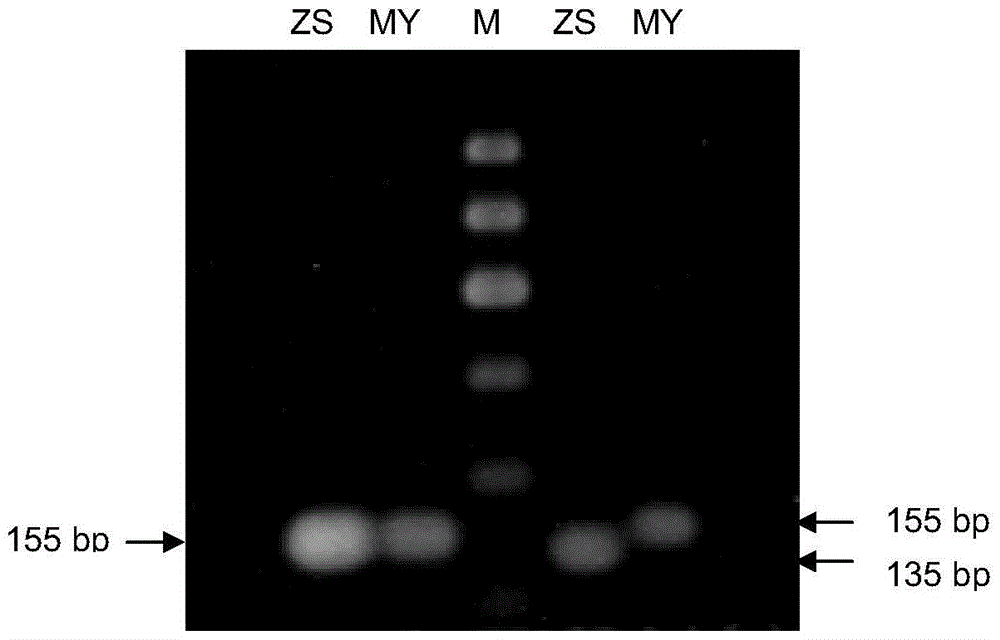Function-specific molecular markers of rice high-yield allele gy6
An allele and molecular marker technology, which is applied in the determination/inspection of microorganisms, DNA/RNA fragments, recombinant DNA technology, etc., can solve the problems of false positives, failure to achieve the expected goal of improvement, deletion of target genes, etc., and saves money Time and cost, improved breeding efficiency, effect of increased screening accuracy
- Summary
- Abstract
- Description
- Claims
- Application Information
AI Technical Summary
Problems solved by technology
Method used
Image
Examples
Embodiment 1
[0019] Example 1 Development of specific molecular markers for GY6 gene
[0020] 1. GY6 allele amino acid sequence alignment and identification of specific amino acid positions
[0021] The sequence alignment software DNASTAR MegAlign module (Lasergene) was used to analyze the amino acid sequence of Zhenshan 97 and Miyang 46 at the GY6 locus (Patent No.: ZL 201210047301.0, SEQ ID No: 3 and SEQ ID No: 6) . The GY6 protein was identified as having differences in 6 amino acid positions, namely A31V, K105E, N144S, K146R, D147N and A160T ( figure 1 ).
[0022] 2. Design of GY6 gene-specific molecular marker primers
[0023] Aiming at the 31st amino acid position among the above 6 amino acid differences, according to the CAPS marker design principle, the online software dCAPS Finder 2.0 (http: / / helix.wustl.edu / dcaps / dcaps.html) and Oligo7.0 are used. (Molecular Biology Insights) Design primers. The upstream primer sequence is 5'-CCGGATCACTAACCTCAGCG-3', and the downstream primer sequence...
Embodiment 2
[0041] Example 2 Verification of GY6 gene-specific molecular markers in near-isogenic populations
[0042] Taking a set of near-isogenic populations derived from Zhenshan 97 / Miyang 46 as materials, this population segregated only in the GY6 interval, containing two genotypes of Zhenshan 97 and Miyang 46. Compared with the latter, the former is true It has a large number of grains, a thousand grains, and a high yield. The GY6 gene specific molecular marker Si2926 / Hha I was tested for function. Using the PCR amplification system and reaction conditions described in Example 1, Si2926 / Hha I was used for amplification and restriction digestion.
[0043] Electrophoresis results ( image 3 ) Showed that Si2926 / Hha I was segregated in the near-isogenic line population. The strains (1-15) with a large number of real grains, a thousand grains and a high yield were all detected with the same band pattern as Zhenshan 97, indicating that they All of them carried the Zhenshan type 97 high-yield...
Embodiment 3
[0044] Example 3 Detection of GY6 gene-specific molecular markers in rice germplasm resources
[0045] Using the functional specific molecular marker Si2926 / Hha I of GY6 gene, 66 indica hybrid rice parents were tested. The results showed that 17 parents carried Zhenshan type 97 alleles and 49 parents carried Miyang type 46 alleles ( Figure 4 ).
[0046] China National Rice Research Institute
[0047] Function-specific molecular markers of rice high-yielding allele GY6
[0048] 2
[0049] PatentIn version 3.3
[0050] 1
[0051] 20
[0052] DNA
[0053] Artificial sequence
[0054] 1
[0055] ccggatcact aacctcagcg 20
[0056] 2
[0057] twenty one
[0058] DNA
[0059] Artificial sequence
[0060] 2
[0061] gcatccaaga tatgatccgt a 21
PUM
 Login to View More
Login to View More Abstract
Description
Claims
Application Information
 Login to View More
Login to View More - R&D
- Intellectual Property
- Life Sciences
- Materials
- Tech Scout
- Unparalleled Data Quality
- Higher Quality Content
- 60% Fewer Hallucinations
Browse by: Latest US Patents, China's latest patents, Technical Efficacy Thesaurus, Application Domain, Technology Topic, Popular Technical Reports.
© 2025 PatSnap. All rights reserved.Legal|Privacy policy|Modern Slavery Act Transparency Statement|Sitemap|About US| Contact US: help@patsnap.com



